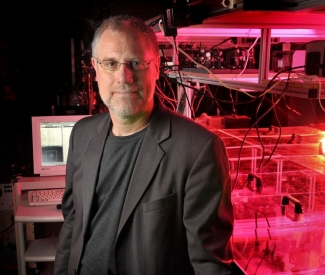The Proceedings of the National Academy of Sciences has just published a profile of Fellow Henry Kapteyn, a recently elected member of the National Academy of Sciences. The profile presents highlights of Kapteyn's life as well as his long and productive career in developing ultrashort-wavelength lasers, including table-top x-ray lasers. Many of Kapteyn's achievements occurred during a long and fruitful collaboration with his wife, Fellow Margaret Murnane. The profile accompanies Kapteyn’s Inaugural Article entitled "A new regime of nanoscale thermal transport: Collective diffusion increases dissipation efficiency."
The article describes how the Kapteyn/Murnane group uncovered a regime of nanoscale thermal transport in which nanoscale heat sources cool more quickly when placed close together than when they are widely separated. This work opens the door to new ways of managing heat in nanosystems and may affect the design of integrated circuits, thermoelectric devices, nanoparticle-mediated thermal therapies, and clean-energy technologies such as photovoltaics.



 The Physics Frontiers Centers (PFC) program supports university-based centers and institutes where the collective efforts of a larger group of individuals can enable transformational advances in the most promising research areas. The program is designed to foster major breakthroughs at the intellectual frontiers of physics by providing needed resources such as combinations of talents, skills, disciplines, and/or specialized infrastructure, not usually available to individual investigators or small groups, in an environment in which the collective efforts of the larger group can be shown to be seminal to promoting significant progress in the science and the education of students. PFCs also include creative, substantive activities aimed at enhancing education, broadening participation of traditionally underrepresented groups, and outreach to the scientific community and general public.
The Physics Frontiers Centers (PFC) program supports university-based centers and institutes where the collective efforts of a larger group of individuals can enable transformational advances in the most promising research areas. The program is designed to foster major breakthroughs at the intellectual frontiers of physics by providing needed resources such as combinations of talents, skills, disciplines, and/or specialized infrastructure, not usually available to individual investigators or small groups, in an environment in which the collective efforts of the larger group can be shown to be seminal to promoting significant progress in the science and the education of students. PFCs also include creative, substantive activities aimed at enhancing education, broadening participation of traditionally underrepresented groups, and outreach to the scientific community and general public.